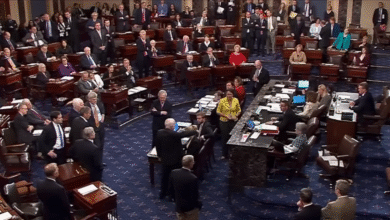Why Politics Is So Insanely Complicated in 2025


All our machines are broken.
Photo-Illustration: Getty Images
Every major news story in the past week had one thing in common: none of it was remotely simple or easy to explain. The basic facts surrounding the U.S. attack on Iran’s nuclear facilities were obscured by walls of secrecy and spin. The New York mayoral primary was hard to predict thanks to the city’s complex ranked choice voting system and the byzantine alliances and rivalries it spawned. And above all, the domestic governance of the country continued to be snarled in arcane judicial, congressional, and executive branch procedures.
Systemic chaos and confusion have been the reigning leifmotif of the second Trump presidency. If your grasp of the way government is supposed to work is based on Schoolhouse Rock or social studies lessons on “how a bill becomes law,” the last five months or so must have been baffling to you. It’s not an accident, either: Donald Trump’s ways of doing business make the normal business practices of the public sector all but impossible.
Congress has done remarkably little this year other than slowly and erratically tinker on the so-called One Big Beautiful Bill. When reconciliation bills were conceived of in the early ‘70s, they were meant to provide some budgetary discipline to Congress. Over time they have become the principle way for majority parties with governing trifectas to enact massive collections of legislation without fear of a Senate filibuster. Reconciliation bills, put simply, are a way to take power from the minority party. They are tailor-made for a president with authoritarian tendencies and largely undivided party support to ram through a vast agenda. And so, unsurprisingly, the 2025 reconciliation bill is bigger and badder than any of its predecessors. During his first term in 2017, Congress packaged Trump’s agenda into two reconciliation bills. This time he insisted on doing everything at once, creating a truly monstrous megabill.
Budget reconciliation bills have their own incredibly obscure and complex set of rules and procedures that confound everyone but a small tribe of budget wonks. There are multiple layers to the development of a megabill, from a budget resolution that sets targets, to “reconciliation instructions” that tell House and Senate committees what to produce in the way of revenues and spending, to all-night Senate “vote-a-ramas” where the minority party gets to offer dozens of symbolic amendments designed to make the majority look bad. Once the assembled bill reaches the Senate, that chamber’s nonpartisan parliamentarian rules on which provisions fail to meet the criteria for inclusion in such bills. Then the majority party will try to put Humpty Dumpty back together by tweaking the offending provisions, or altering other items to make the overall arithmetic work. All this is happening very quickly, and largely behind the scenes. And then the House has to accept changes made by the Senate or the whole wild process more or less starts over.
Figuring out where things stand at any given moment with a reconciliation bill is all but impossible, so people rely on big partisan narratives. To Republicans, Trump’s Big Beautiful Bill is a carefully wrought device to extend and create tax cuts for people who deserve them; to boost national defense and border security spending; to reverse the “open borders” policies of the Biden administration; and to reduce government “waste, fraud and abuse.” To Democrats it’s an abominable reverse-Robin Hood measure to give tax cuts to the wealthy at the expense of vulnerable poor and middle-class Americans, whose Medicaid, Obamacare, and SNAP benefits will be slashed. Each party accuses the other of fiscal profligacy. Sometimes Republicans jockeying for leverage in their own caucuses temporarily agree with Democrats and yell and posture, but it’s understood that in the end they will toe the party line. No one will read the final bills that Trump will likely push through the House and Senate. So how can citizens comprehend the consequences until the dust clears and the new laws are fully implemented? They really can’t; it’s all based on partisanship, trust, selective information, and gut instincts. Civics in action it isn’t. And it’s all being done this way because Trump has insisted on making the Big Beautiful Bill a testament to his own power and historical significance.
The chaos in the judicial branch is arguably even worse. Since the Trump administration is determined to expand presidential powers to the breaking point, it is inviting and sometimes initiating litigation in the federal courts on a vast array of issues. In general challenges to Trump’s policies have succeeded more often than not in the lower courts. But many issues will only be resolved when they reach a deeply divided U.S. Supreme Court. Indeed, on the final day of that Court’s current term, the conservative majority restricted the ability of lower-court judges to put a hold on the administration’s many power grabs through nationwide injunctions. So more than ever, all roads lead to incredibly high-stakes decisions by the Supreme Court, three of whose members owe their life-time appointments to Trump.
That same Supreme Court, moreover, is increasingly prone to issuing temporary orders with no explanation. This often helps the administration work its will, but leaves a lot of questions unresolved, as the Brennan Center recently explained:
Today, the justices grant relief in contentious shadow docket cases twice as often as they did just a few years ago. The surge in issuing this relief has coincided with Justices Neil Gorsuch, Brett Kavanaugh, and Amy Coney Barrett joining the Court.
It’s hard to avoid the suspicion that Supreme Court conservatives are trying to hide their tracks on controversial cases. Just this week the Court permitted the administration to resume deporting immigrants to random and often dangerous countries other than their own without a hearing — and the decision was made with no oral arguments and no majority opinion. Who knows what it means in the long run? Those without a law school education and a huge amount of time on their hands will be lost trying to follow it all.
On top of everything else, the Trump 2.0 executive branch has engaged in an incredible amount of secrecy and procedural chaos, all of it making it hard to know what will happen to the federal government and millions of federal employees. Elon Musk’s DOGE initiative may be winding down a bit with its chief’s recent departure from the administration. But the damage it wreaked throughout the public sector via arbitrary mass firings, lockdowns of agencies and programs, refusals to pay invoices, and sheer terror tactics by embedded teams of totally inexperienced data geeks, will live on for years. And anyone relying on, much less working on, federal programs and benefits will be seeing shadow ninjas jumping out of the walls to blow it all up for a long time.
Post-Musk, Office of Management and Budget Director Russell Vought has emerged as the real quarterback of executive branch aggressive chaos. The steely Christian nationalist and Project 2025 co-creator wants to shrink the federal government radically. He’s renowned for pursing all sorts of obscure power-grabbing measures that only a handful of people fully understand, including spending rescissions (cancellation of previously appropriated funds, which must be approved by Congress), spending deferrals (delays in releasing previously appropriated funds, which can be overriden by Congress), “pocket rescissions” (deferrals issued just before the end of the fiscal year so that Congress won’t have time to override them), and impoundments (blatant refusals to spend appropriated dollars). It’s all in play.
Top it all off with a powerful president who is famously erratic, and it’s hard to see the road ahead, or even the road underneath one’s feet right now. To understand any given issue you need to know where it stands in the latest version of the budget bill; whether it’s subject to federal court litigation; what the executive branch is doing to undermine the prerogatives of Congress and the courts; and what priorities Trump may choose at any given moment. It’s a lot, every minute of every day, and the relentless chaos fostered by the 47th president continues to defy every single precedent.
Source link





